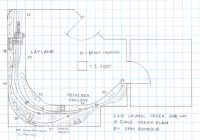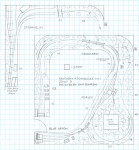N&W Pocahontas Main, WV track plan O

- Size: 13′ x 46 ′
- Scale: O
- Minimum Radius: 56″
- Minimum Aisle Width: 36″
- Designed by Dan Bourque
 The N&W’s Pocahontas Division Mainline was the heart of the N&W. The double-track main cut through the mountains of the West Virginia coal fields with branch lines of various sizes plying the hollers and feeding an endless string of coal hoppers to the main. As the N&W’s main east-west artery, the “Pokey” main also hosted numerous non-coal freights and the N&W’s hottest passenger trains. Add in dozens of tunnels and bridges, small mountain towns and some company towns, and you’ve got the makings of a great model railroad in … Read more
The N&W’s Pocahontas Division Mainline was the heart of the N&W. The double-track main cut through the mountains of the West Virginia coal fields with branch lines of various sizes plying the hollers and feeding an endless string of coal hoppers to the main. As the N&W’s main east-west artery, the “Pokey” main also hosted numerous non-coal freights and the N&W’s hottest passenger trains. Add in dozens of tunnels and bridges, small mountain towns and some company towns, and you’ve got the makings of a great model railroad in … Read more







 The K&T was a compact little road that ran short trains to a handful of loaders. As such it makes a great subject for a layout of modest proportions or a layout of a larger scale.
The K&T was a compact little road that ran short trains to a handful of loaders. As such it makes a great subject for a layout of modest proportions or a layout of a larger scale.